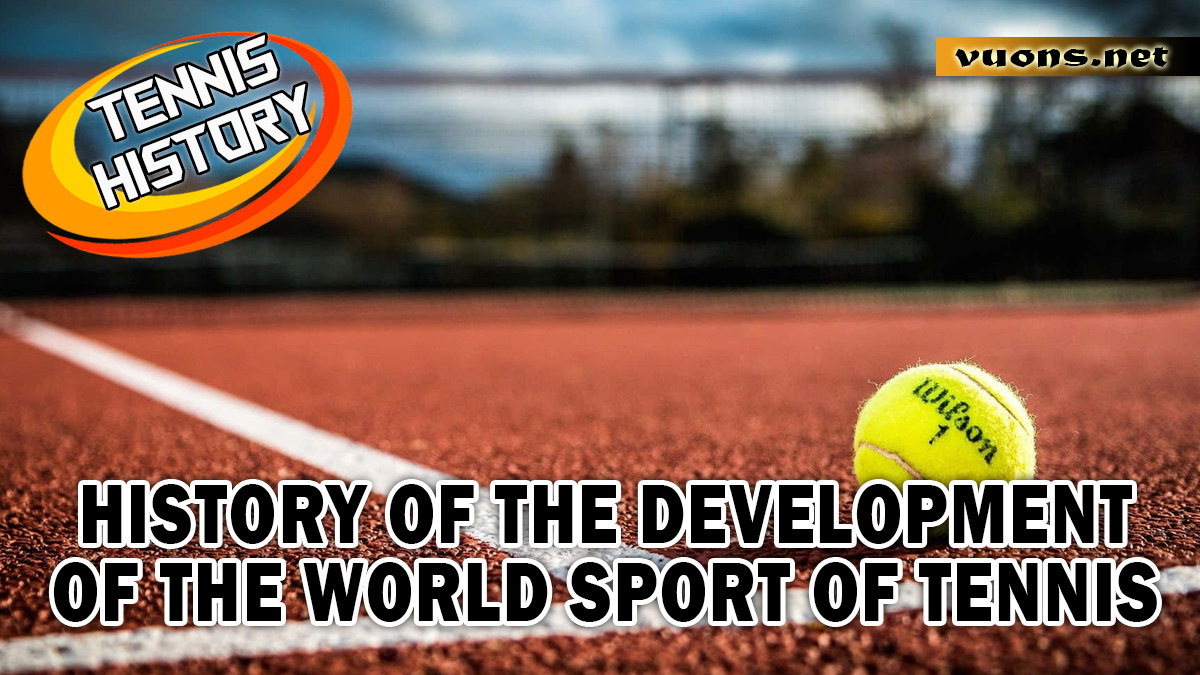History of the Development of World Tennis
Origins and Early Evolution of the Sport of Tennis
The Sport of tennis has a long history that began in the 12th century in France. Originally, the game was known as jeu de paume, which means “game of the hand.” Players hit the ball using the palm of their hand, before rackets were introduced in the 16th century. In those days, tennis was played by European nobility on indoor courts, making it a symbol of social status.
Tennis continued to develop from an indoor game to an outdoor sport in the 19th century in England. This was the beginning of the emergence of lawn tennis, which is the earliest form of modern tennis that we know today. Along with these changes, new rules began to be implemented, including court size, use of the net, and the introduction of love, deuce, and advantage scores which are still used in modern tennis matches.
In 1874, Major Walter Clopton Wingfield of England introduced a new version of this game which he called lawn tennis. This version immediately gained wide popularity, especially after the holding of the first Wimbledon tournament in 1877. Wimbledon, which took place on grass courts, became the oldest and most prestigious tournament in the history of tennis.
Over time, tennis evolved into a sport that is known and played globally. With the advent of major tournaments and international associations governing the sport, tennis changed from a game of nobility to a sport that could be enjoyed by all levels of society. This evolution became the basis for the development of professional tennis involving advanced technology and the world’s top players who inspired new generations.
The Birth of Modern Tennis and the Role of England
The birth of modern tennis cannot be separated from England’s important role in developing and introducing new rules. In the mid-19th century, the British refined an early form of tennis into what is known as lawn tennis. Major Walter Clopton Wingfield, a British officer, in 1874 introduced a formal version of tennis with more structured rules. This version was designed to be played on grass courts, unlike the previously popular indoor games in Europe.
Lawn tennis quickly caught the attention of the British public, and in 1877, the All England Club at Wimbledon hosted the first tennis tournament. This tournament, which became known as the Wimbledon Championships, remains the most prestigious tennis event to this day. From here, standard tennis rules were born which include court size, use of the net, as well as a scoring system which includes unique terms such as love, deuce and advantage.
England’s role in popularizing modern tennis is also seen in the spread of the sport to Commonwealth countries, including the United States and Australia. In the late 19th century, tennis began to develop rapidly in various parts of the world, with England becoming the center of international rules and standards of the game.
With the arrival of Wimbledon and innovations in equipment, such as modern rackets and better balls, England not only gave birth to modern tennis but also played a major role in its transformation into a competitive global sport. International tennis tournaments and associations continued to develop based on the foundations laid by the British in that era.
The Development of Tennis in the United States and Australia
The development of tennis in the United States and Australia began in the late 19th century, when the sport began to spread from England. In the United States, tennis was first played by the elite in exclusive clubs. In 1881, the United States Tennis Association (USTA) was formed to organize official tournaments and competitions, which later gave birth to the first Grand Slam tournament in the US, the US Open. Over time, the US Open has become one of the most prestigious tennis tournaments in the world, with top players competing there every year.
Australia is also not left behind in the development of tennis. Tennis was introduced to Australia in the late 19th century, and quickly became popular. In 1905, Australia held its first national tennis tournament, which later evolved into the Australian Open, one of the four Grand Slam tournaments. The Australian Open was originally played on grass courts, following British tradition, but in 1988 the tournament moved to hard courts, which are more in line with modern tennis developments.
These two countries, the United States and Australia, play an important role in the globalization of tennis through hosting major tournaments and developing talented players. Legendary players from both countries, such as Pete Sampras, Serena Williams, Rod Laver and Margaret Court, helped strengthen tennis’ position on the international stage. To this day, the US and Australia continue to be centers for international tennis competition, with infrastructure that supports young athletes and major tournaments that attract global attention.
The Impact of Globalization on the Popularity of Tennis
Globalization has had a huge impact on the popularity of tennis around the world. With advances in technology and communication, this sport, which was once concentrated in Europe and the United States, is now enjoyed globally. Television broadcasts and streaming platforms make it possible for major tournaments such as Wimbledon, the US Open, the Australian Open and the French Open to be accessed by millions of people in various countries. This increased the visibility of tennis and attracted interest from a wider audience.
Additionally, the emergence of star players from various parts of the world, such as Spain’s Rafael Nadal, Serbia’s Novak Djokovic and Japan’s Naomi Osaka, has helped develop a more diverse fan base. These players became global icons who inspired a new generation of young athletes around the world to get involved in tennis.
International tournaments held in various countries have also been an important factor in the spread of tennis. Countries such as China, India and the Middle East are starting to host world-class tournaments, attracting local and international interest. Tennis infrastructure in these countries is also developing rapidly, strengthening tennis’ position as a global sport.
Sponsorship from multinational companies has helped accelerate the globalization of tennis, with big brands supporting tournaments and players from various countries. This creates an increasingly inclusive competitive environment and encourages the development of tennis in a region previously little known for the sport.
The impact of globalization is not only limited to the growth in the number of players and fans, but also to technological innovations in equipment and facilities, which improve the quality of the game at professional and amateur levels.




